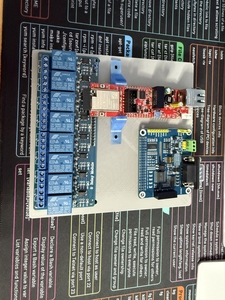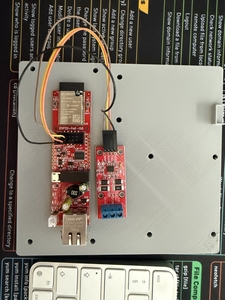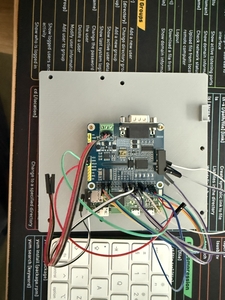Posted by: @bensonAnyone able to advise at all?
I' d like to see a graph of that. It doesn't make sense to me, unless he means that at low temps, the pump runs at constant speed.
Midea MHCV10WD2N7 R290, 5.8kWp energy community solar power.
Posted by: @bensonAnyone able to advise at all?
I' d like to see a graph of that. It doesn't make sense to me, unless he means that at low temps, the pump runs at constant speed.
I agree, the video lacks context and detail, and the Midea Engineering Data manual is even briefer:
"ZONE1 H-EMISSION sets the emission type for heating mode."
The radiator as opposed to UFH question appears in the comments below the video, but there is no useful answer.
Mr Graham Hendra (@grahamh), maker of the video, and late of Freedom Heat Pumps, is a member of this forum. He may be able to provide further details.
Midea 14kW (for now...) ASHP heating both building and DHW
This is a very interesting thread I am currently deep into the rabbit hole of building my own smart controller pretty similar to the svenarr but with added dry contacts for my Grant Aerona3. I started off with an esp32 module, a modbus hat for a raspberry pi and an 8 channel coil relay module but as I have iterated I have learned that the esp32 module can handle the switching itself and I sourced a much smaller modbus module. So I have ended up building two prototypes one that will plumb into my existing home assistant system to replace my Waveshare modbus converter and 8 channel relay (the two new red modules), and a RPi zero W with the modbus hat, that will be a standalone Home Assistant instance with full modbus control as well as switching. I am going to add a couple of RJ45 terminals and terminals for thermistors (tank and buffer tank if needed) so it should be a neat little unit when done. All the user (me and maybe a mate!) will need to do is run two cat5 cables out to the unit attach the wires to the PCB (I will create a wiring guide) and then plug the cables into the box and then will have either wired (PoE) connectivity of USB powered wifi connectivity to the heatpump.
Kind Regards
Si
——————————————————————————
Grant Aerona3 13kW
13 x 435w + 13x 480w Solar Panels
Sigenergy 10kW Inverter
16kW Sigenstor battery
I am also looking into the Grant R290 as it may also be a Exinda/Midea clone as I want to add this to my Home Assistant Integration. Obvs not owning one makes researching (read tinkering!) difficult lol!
Kind Regards
Si
——————————————————————————
Grant Aerona3 13kW
13 x 435w + 13x 480w Solar Panels
Sigenergy 10kW Inverter
16kW Sigenstor battery
@grantmethestrength - thanks for the contribution, very interesting. Not everyone will want to do this sort of thing, but for those that do, reading about and seeing what others have done is very useful. I do like wired connections, once wired up they are far more reliable than wireless connections (until the rodents get to the cables...).
Midea 14kW (for now...) ASHP heating both building and DHW
Posted by: @cathoderay@grantmethestrength - thanks for the contribution, very interesting. Not everyone will want to do this sort of thing, but for those that do, reading about and seeing what others have done is very useful. I do like wired connections, once wired up they are far more reliable than wireless connections (until the rodents get to the cables...).
yeah I have opted for the PoE option as I prefer wired, but I realise others may need a wireless solution and are more likely to have power close to their ASHP rather than a couple of ethernet runs out of their house. Both versions could be located outside in an enclosure close to the ASHP with a couple of short ethernet runs into the unit. I already piped two cables out to my unit so I will put this where my current controls are. I just need to learn how to solder and we are good to go!
Kind Regards
Si
——————————————————————————
Grant Aerona3 13kW
13 x 435w + 13x 480w Solar Panels
Sigenergy 10kW Inverter
16kW Sigenstor battery
Posted by: @cathoderay@grantmethestrength - thanks for the contribution, very interesting. Not everyone will want to do this sort of thing, but for those that do, reading about and seeing what others have done is very useful. I do like wired connections, once wired up they are far more reliable than wireless connections (until the rodents get to the cables...).
I did look at your suggestion of minimal modbus but as I am deep down the Home Assistant rabbit hole I have parked that for now but it does look like a good stand alone solution.
Kind Regards
Si
——————————————————————————
Grant Aerona3 13kW
13 x 435w + 13x 480w Solar Panels
Sigenergy 10kW Inverter
16kW Sigenstor battery
@grantmethestrength that looks really good albeit must profess to not fully understanding all of what you have said! I'd love to have the knowledge to build such a device myself as you are doing, alongside learning some basic coding. Perhaps when I finish renovating our house (not too far off finishing), I'll delve into it a bit more. For now, the ready made svenar was absolutely ideal for us.
Posted by: @benson@grantmethestrength that looks really good albeit must profess to not fully understanding all of what you have said! I'd love to have the knowledge to build such a device myself as you are doing, alongside learning some basic coding. Perhaps when I finish renovating our house (not too far off finishing), I'll delve into it a bit more. For now, the ready made svenar was absolutely ideal for us.
This is actually based on the same chipset as the Svenar and if it wasn’t for my need to control dry contact switches the Svenar would have been a decent solution. Once I (read me and my AI overlords) have this working I am going to reach out to Sven and his dad and share my work as I really like their project.
Kind Regards
Si
——————————————————————————
Grant Aerona3 13kW
13 x 435w + 13x 480w Solar Panels
Sigenergy 10kW Inverter
16kW Sigenstor battery
Regarding the warm end of the WC curve, are there any particular parameters that people would recommend? I had it set as 31 degrees C at 16, which is working ok but leading to a fair bit of overshooting. With homely my minimum outlet flow temperature was set at 35 so I have it (perhaps incorrectly) set in my mind that I shouldn't be going much lower than this. I have just slightly adjusted to 31 degrees C at 14.
Furthermore I guess this is the time of year when the heating might just need to be turned on and off when a bit cold as it isn't quite 'full' heating season yet...
If it helps, my outlet is running at 25C.
It would seem to be erroneous that someone set a minimum flow temperature in the controller if you were using the homely, that is going to limit it’s low end (most efficient) range for no good reason. The high end range mayb necessary, but only if you have heat sensitive emitters, ie UFH.
Posted by: @bensonRegarding the warm end of the WC curve, are there any particular parameters that people would recommend? I had it set as 31 degrees C at 16, which is working ok but leading to a fair bit of overshooting.
This really depends on your heat loss and emitters. My installer and I seem to have been too pessimistic about the heat loss and maybe overshot on radiator upgrades, but that is a nice place to be.
At the moment it is 5.8C outside and 19.7C inside (target 20C). My system is breezing along with a flow temperature of 30.4C.
When it is 16C outside, I can’t get the flow temperature below 27-29C. The heat pump compressor won’t go slower than 15Hz. This doesn’t seem to be a problem, as in warmer weather it turns on and off maybe once every 2-3 hours.
Grant Aerona 290 15.5kW, Grant Smart Controller, 2 x 200l cylinders, hot water plate heat exchanger, Single zone open loop system with TRVs for bedrooms & one sunny living room, Weather compensation with set back by room thermostat based load compensation
- 26 Forums
- 2,338 Topics
- 52.8 K Posts
- 193 Online
- 5,994 Members
Join Us!
Podcast Picks
Latest Posts
-
RE: Home energy storage & battery register
I have Solax X1-AC with 5.8kWh. Last month we install...
By williamp , 1 hour ago
-
RE: Grant Aerona Short Cycling
@damonc if you have the R32 ASHP it will have the modbu...
By Grantmethestrength , 1 hour ago
-
RE: What a Bad Heat Pump Installation Looks Like
Tbh I dont think we want government interfering when th...
By JamesPa , 2 hours ago
-
RE: Aira Heat Pump: Stylish Scandinavian Heating
Thanks @gmuzz @mikeh They still mention on the app t...
By ChandyKris , 5 hours ago
-
RE: Experience with Mitsu Par 50/60 Wireless Controller
The 27°C request doesn't boost the weather compensation...
By Sheriff Fatman , 21 hours ago
-
RE: Getting the best out of a heat pump - is Homely a possible answer?
Oh and it was installed by Stevie Wonder!
By Grantmethestrength , 23 hours ago
-
There seems to be plenty of evidence to support this. ...
By JamesPa , 1 day ago
-
RE: One Year Review: Grant 13kW ASHP - A Catalogue of Errors
@solenoid it sounds like you are making progress. No n...
By JamesPa , 1 day ago
-

RE: LiFePO4 lithium battery fires and explosions
@iaack — thanks, a useful video. They do make it clear...
By cathodeRay , 1 day ago
-
RE: How good is the app support for your heat pump?
I think you are right about the ebus stick. It's cert...
By JamesPa , 2 days ago
-

RE: My DIY Heat Pump installation
@majordennisbloodnok Element-ary my Dear Major.
By Toodles , 2 days ago
-
RE: Replacing my 18 month old Hitachi Yutaki ASHP
Yes, you can work out a lot from a plot of FT. Interes...
By JamesPa , 2 days ago
-

Welcome to the forums @isaac. What you’re describing is...
By Mars , 2 days ago
-

Win an Eve Smart Home Bundle worth over £350!
Win an Eve Smart Home Bundle worth over £350! ...
By Mars , 2 days ago
-
RE: Is your heat pump insured?
I chose Tesco in the end. Unambiguously cover HP, PV an...
By Davesoa , 2 days ago
-
RE: Help me keep the faith with my air source heat pump installation
@adamk You can get an idea of if your flow and return...
By SimonF , 3 days ago
-
This Solis inverter being rated 8kw and (I expect, as I...
By Batpred , 3 days ago
-
RE: A2A vs A2W: Which Heat Pump Would You Pick?
I have one fancoil in an otherwise all radiator system....
By JamesPa , 3 days ago







